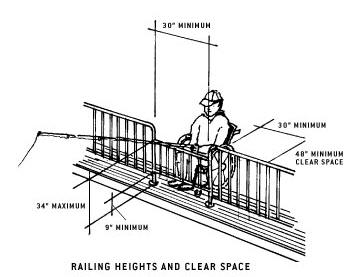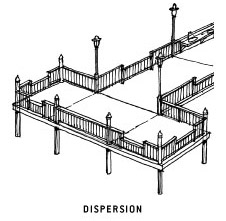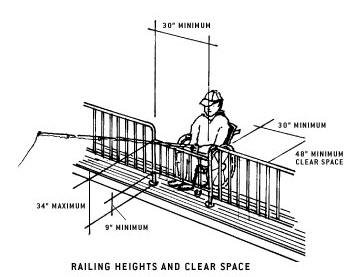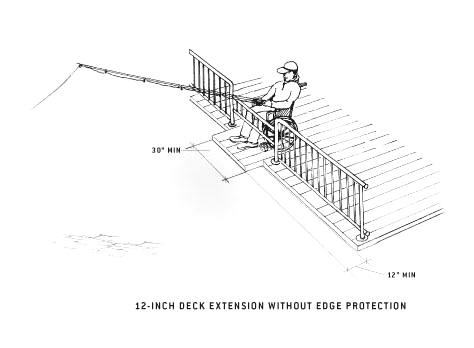Accessible Fishing Piers and Platforms - A Summary of Accessibility Guidelines for Recreation Facilities
Railings
Where railings, guards, or handrails are provided on a fishing pier or platform, they must meet ADAAG provisions.
Height
Where railings, guards, or handrails are provided on a fishing pier or platform, at least 25 percent of the rails must be 34 inches or less in height above the ground or deck so a person using a wheelchair or other mobility device has the opportunity to fish. However,guardrails may be higher than 34 inches if the higher portion meets all the requirements of the International Building Code. (See 2000 International Building Code, below.) This will allow a design professional to increase the guardrail height if a specific location needs enhanced safety measures or a local building code applies.
Dispersion
Anglers who can stand are able to fish from any part of a pier or platform and change locations. To provide anglers with disabilities similar opportunities, the accessible 34-inch maximum railing must be located in a variety of places on the pier or platform to offer a variety of locations to fish from. Different fishing locations may provide different water depths, shade or sun, vegetation, and proximity to the shoreline or bank.
Edge Protection
Where railings, guards, or handrails are provided, edge protection must be provided and extend a minimum of 2 inches above the ground or deck surface. This protection will prevent persons using wheelchairs or other mobility devices from slipping off the pier or platform.
Edge protection is not required where a railing, guardrail, or handrail is provided, if the deck surface extends a minimum of 12 inches beyond the inside face of the railing. This design allows a person using a wheelchair or other mobility device to pull into a clear space and move beyond the face of the railing to view the water in different directions. Toe clearance must be at least 30 inches wide and a minimum of 9 inches above the ground or deck surface beyond the railing.
Clear Floor or Ground Space
At least one clear floor or ground space (30 inches by 48 inches minimum) must be provided at each location that has a railing height of 34 inches maximum. If there are no railings, at least one clear space must be provided on a pier or platform. (See illustration above, Railing Heights and Clear Space.)
Turning Space
Piers and platforms must have at least one turning area, either a 60-inch turning space or T-shaped space, to allow a person using a mobility device or wheelchair to make a 180-degree turn. The space may overlap the accessible route and clear floor or ground space.
2000 International Building Code
1003.2.12.1 Height.
Guards shall form a protective barrier not less than 42 inches (1067 mm) high, measured vertically above the leading edge of the tread, adjacent walking surface or adjacent seatboard.
Exception:For occupancies in Group R-3, and within individual dwelling units in occupancies in Group R-2, both as applicable in Section 101.2, guards whose top rail also serves as a handrail shall have a height not less than 34 inches (864mm) and not more than 38 inches (965mm) measured vertically from the leading edge of the stair tread nosing.
1003.2.12.2 Opening limitations.
Open guards shall have balusters or ornamental patterns such that a 4-inch-diameter (102mm) sphere cannot pass through any opening up to a height of 34 inches (864mm). From a height of 34 inches (864mm) to 42 inches (1067mm) above the adjacent walking surfaces, a sphere 8 inches (203mm) in diameter shall not pass.
Exception: The triangular opening formed by the riser, tread and bottom rail at the open side of a stairway shall be of a maximum size such that a sphere of 6 inches (152mm) in diameter cannot pass through the opening.
[Exceptions 2 through 4 not reprinted.]
Source: Sections 1003.2.12.1 and 1003.2.12.2, International Building Code. Reprinted with permission of the International Code Council, Falls Church, Virginia.





User Comments/Questions
Add Comment/Question